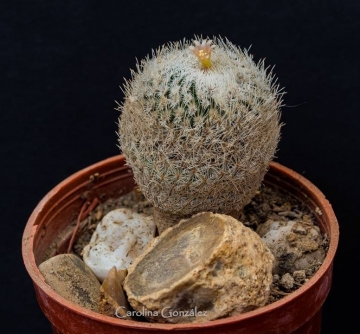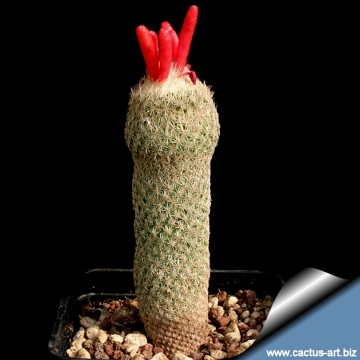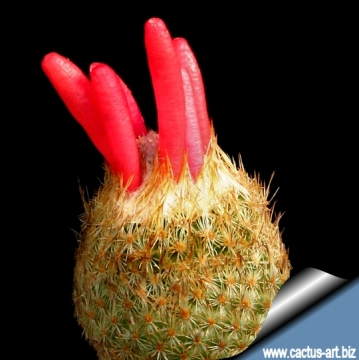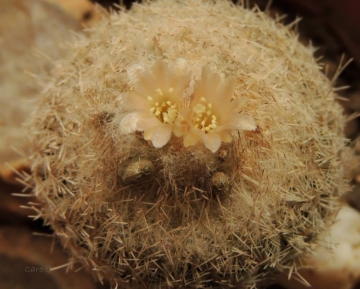Donate now to support the LLIFLE projects.
Your support is critical to our success.
Your support is critical to our success.
= Epithelantha micromeris var. rufispina (Bravo) Backeb.
Cactus (Paris) no. 39: 31. 1954
Accepted Scientific Name: Epithelantha micromeris (Engelm.) F.A.C.Weber in Bois
Dict. Hort. [Bois] 2: 804. 1898 Britton & Rose, Cactaceae, 3: 93, fig. 102. 1922 Bois

Epithelantha rufispina (Epithelantha micromeris var. rufispina) Photo by: Valentino Vallicelli
Apical spines in mature plants take a reddish tinge, especially if wet.
Apical spines in mature plants take a reddish tinge, especially if wet.
Synonyms:
- Epithelantha micromeris var. rufispina (Bravo) Backeb.
- Epithelantha greggii var. rufispina (Bravo) Backeb.
- Epithelantha rufispina Bravo
See all synonyms of Epithelantha micromeris
back
Accepted name in llifle Database:Epithelantha micromeris (Engelm.) F.A.C.Weber in Bois
Dict. Hort. [Bois] 2: 804. 1898 Britton & Rose, Cactaceae, 3: 93, fig. 102. 1922
Synonymy: 16
- Epithelantha micromeris (Engelm.) F.A.C.Weber in Bois
- Cactus micromeris (Engelm.) Kuntze
- Cephalomamillaria micromeris (Engelm.) Frič
- Echinocactus micromeris (Engelm.) F.A.C.Weber in Bois
- Mammillaria micromeris Engelm.
- Epithelantha micromeris var. caespitosa Y.Itô
- Epithelantha micromeris f. cristata hort.
- Epithelantha micromeris var. longispina Y.Itô
- Epithelantha micromeris var. neomexicana n.n.
- Epithelantha micromeris var. rufispina (Bravo) Backeb.
- Epithelantha greggii var. rufispina (Bravo) Backeb.
- Epithelantha rufispina Bravo
- Epithelantha micromeris var. texensis n.n.
- Epithelantha micromeris var. texensis f. cristata hort.
- Epithelantha micromeris var. typica Croizat
Epithelantha micromeris var. dickisoniae hort.
Synonymy: 3 Accepted name in llifle Database:
Epithelantha micromeris subs. greggii (Engelm.) N.P.Taylor
Cactaceae Consensus Init. 5: 12. 1998
Synonymy: 12
- Epithelantha micromeris subs. greggii (Engelm.) N.P.Taylor
- Cactus micromeris var. greggii (Engelm.) J.M.Coult.
- Cephalomamillaria greggii var. greggii (Engelm.) Frič
- Cephalomamillaria micromeris var. greggii cv. Gray Herb. CardCat., Issue 114 (Engelm.) Frič
- Epithelantha greggii (Engelm.) Orcutt
- Epithelantha micromeris var. greggii (Engelm.) Y.Itô
- Mammillaria greggii (Engelm.) Saff.
- Mammillaria micromeris var. greggii Engelm.
- Epithelantha greggii subs. potosina D.Donati & Zanov.
- Epithelantha micromeris var. densispina (Bravo) Backeb.
- Epithelantha densispina Bravo
- Epithelantha greggii var. densispina (Bravo) Backeb.
Epithelantha micromeris subs. greggii f. cristata
Synonymy: 2 Accepted name in llifle Database:
Epithelantha micromeris subs. pachyrhiza (W.T.Marshall) N.P.Taylor
Cactaceae Consensus Init. 5: 13. 1998
Synonymy: 6
- Epithelantha micromeris subs. pachyrhiza (W.T.Marshall) N.P.Taylor
- Epithelantha micromeris var. pachyrhiza W.T.Marshall
- Epithelantha pachyrhiza (W.T.Marshall) Backeb.
- Epithelantha micromeris f. elongata (Backeb.) Bravo
- Epithelantha pachyrhiza subs. elongata (Backeb.) D.Donati & Zanov.
- Epithelantha pachyrhiza var. elongata Backeb.
Epithelantha micromeris subs. pachyrhiza f. cristata
Accepted name in llifle Database:
Epithelantha micromeris subs. polycephala (Backeb.) Glass
Guía Identif. Cact. Amenazadas México 1: Ep/mi ssp. polycephala (1998 publ. 1997)
Synonymy: 4
- Epithelantha micromeris subs. polycephala (Backeb.) Glass
- Epithelantha greggii subs. polycephala (Backeb.) D.Donati & Zanov.
- Epithelantha micromeris var. polycephala (Backeb.) Glass & R.A.Foster
- Epithelantha polycephala Backeb.
Epithelantha micromeris subs. unguispina (Boed.) N.P.Taylor
Cactaceae Consensus Init. . 5: 12. 1998
Synonymy: 6
- Epithelantha micromeris subs. unguispina (Boed.) N.P.Taylor
- Epithelantha micromeris var. unguispina (Boed.) Backeb.
- Epithelantha unguispina (Boed.) D.Donati & Zanov.
- Mammillaria micromeris var. unguispina Boed.
- Epithelantha spinosior
- Epithelantha unguispina subs. huastecana D.Donati & Zanov.
back

Epithelantha rufispina (Epithelantha micromeris var. rufispina) Photo by: Carolina González

Epithelantha rufispina (Epithelantha micromeris var. rufispina) Photo by: Cactus Art

Epithelantha rufispina (Epithelantha micromeris var. rufispina) Photo by: Cactus Art

Epithelantha rufispina (Epithelantha micromeris var. rufispina) Photo by: Carolina González
| Your Actions | |
|---|---|
| Back to Epithelantha index | |
| Back to Cactaceae index | |
 |
Back to Cacti Encyclopedia index |








